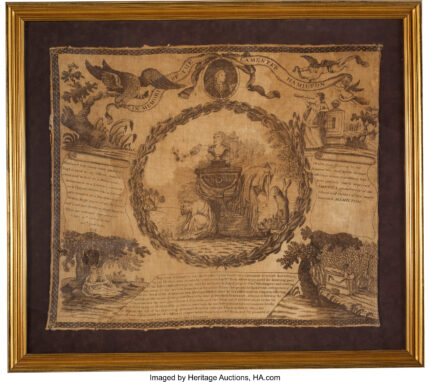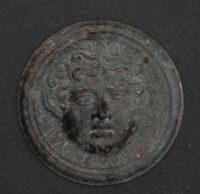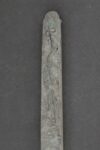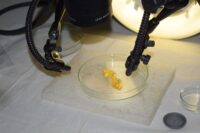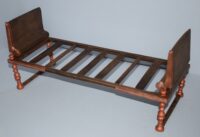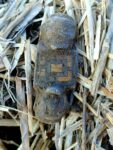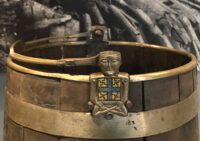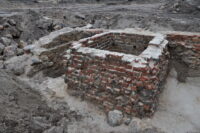 A latrine from the 14th century has been raised intact from its find site on Fischerinsel, central Berlin, so it can be preserved, studied and eventually put on display. Just under six feet square and 6.5 feet deep, the latrine was built using large-format bricks and is one of the oldest secular brick structures surviving in Berlin.
A latrine from the 14th century has been raised intact from its find site on Fischerinsel, central Berlin, so it can be preserved, studied and eventually put on display. Just under six feet square and 6.5 feet deep, the latrine was built using large-format bricks and is one of the oldest secular brick structures surviving in Berlin.
Fischerinsel, the south section of Spree Island on the River Spree, is where the city of Cölln was founded in the 13th century. Its twin city Altberlin (Old Berlin) was founded on the other bank of the Spree shortly thereafter. They shared a common administration — city hall was built literally in the middle of a bridge between them — for centuries until Frederick I of Prussia officially merged the two to form the single city of Berlin in 1710.

As the germ cell of what would become Berlin, Fischerinsel is an archaeologically sensitive area, so it was excavated in 2016 in advance of a planned real estate development at the site. The dig revealed traces of the city going back to its earliest days around 1200, including cellars, foundations, courtyards, paths, wells and the prize pig at the fair: the brick latrine.
The fill inside of it — animal bones, broken pottery — dates to the 14th century, which is the source of the tentative dating of the latrine, but these were filled and emptied repeatedly over the course of their use, so the latrine itself could be a little older. The use of brick is an example of how the city was growing as prospering so soon after its founding. Most of the early structures of Cölln and Altberlin were made of wood. The latrine was an expensive feature, likely built for a private dwelling.
 The real estate development is moving forward and has now reached the stage where the latrine had to be removed to make way for new construction. (Full disclosure: I tried to insert a “shit or get off the pot” gag here, but couldn’t figure out how to phrase it. I refuse to just walk away, though, hence this interjection.) To put as little stress as possible on the structure, it was stabilized in situ. Restorers strengthened the mortar, filled large cracks and packaged it with reinforced padding before building a custom crate around it. That crate was then craned to an interim storage area right next to the excavation pit.
The real estate development is moving forward and has now reached the stage where the latrine had to be removed to make way for new construction. (Full disclosure: I tried to insert a “shit or get off the pot” gag here, but couldn’t figure out how to phrase it. I refuse to just walk away, though, hence this interjection.) To put as little stress as possible on the structure, it was stabilized in situ. Restorers strengthened the mortar, filled large cracks and packaged it with reinforced padding before building a custom crate around it. That crate was then craned to an interim storage area right next to the excavation pit.
The latrine will remain there until 2023 when it will be moved to a green space of the new building. A pavilion will be built around it to protect it from the elements while still making it accessible to the public.


